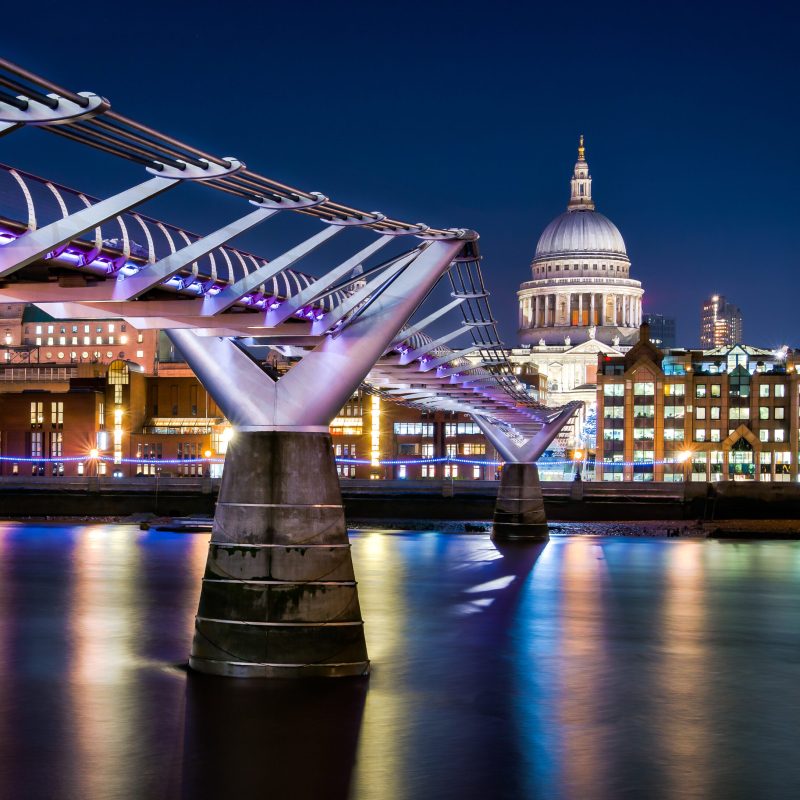
Millennium Bridge / Anthony Sullivan / Shutterstock
London, England, a bustling city full of history and modern attractions, is made up of distinct neighborhoods easily explored on foot. A walk through the Bankside district, located on the south side of the Thames River in the Borough of Southwalk, offers views of the Thames and the north bank, and takes you to a thousand-year-old market, palace ruins, a prison museum, Shakespeare’s theater, a modern art gallery and historic pubs.
Videos by TravelAwaits
Bankside is located between Blackfriars Bridge and London Bridge. For centuries London Bridge was the only river crossing. Anyone traveling south from the city of London traveled over that bridge and through the Southwalk area. Taverns on the south side serviced the tourist trade in medieval times. Later the area became home to brothels and theaters, which were banned in the city of London on the other side of the river. By the 19th century, it was an industrial center. Southwalk was heavily damaged by German bombing in the Second World War, after which the area went into decline. Recent development has turned it into a vibrant district and prime tourist destination.
London Bridge Station is a good spot to start and end your exploration of the area, starting at Borough Market before heading down Cathedral and Clink Streets to Bankside.

1. Borough Market
Borough Market, located at 8 Southwark Street next to London Bridge station, is London’s oldest food market. Signs in the Underground and mainline rail stations mark the way.
This gourmet food market contains well over a hundred fruit, vegetable, fish, meat, bakery, cheese, artisan food product and street food stalls in a combination of open spaces and passageways. Take in the sights and the smells. Taste samples. Talk to the stall owners about their products. Stop for coffee and/or breakfast here before continuing your walk.
The Full Market is open Wednesday through Saturday. A Limited Market, with fewer shops and stalls open, runs on Mondays and Tuesdays. The market is closed on Sundays.
2. Southwark Cathedral
Follow Bedale Street to Cathedral Street upon leaving Borough Market and you’ll pass Southwark Cathedral. It has only been a cathedral since 1905, but its history goes back much further.
Between 1106 and 1538, it was an Augustine priory known as St Mary Overie. At the Dissolution of the Monasteries in 1539, it became the property of King Henry VIII and was renamed St. Saviour’s. In 1611 a group of merchants within the congregation renting the space purchased it. It was restored in the mid-19th century and major extensions were added in 2000.
One feels a sense of history just walking by this building. For a better appreciation of its Norman and Gothic architectural elements, drop-in tours are led by Cathedral guides on select days. Note that this is an active parish and access to certain areas is restricted during times of service and other events. Check the website for recommended visiting times.

3. The Golden Hinde
Continue along Cathedral Street toward the river and you’ll find the Golden Hinde, a historically accurate representation of the ship in which Sir Francis Drake circumnavigated the world between 1577 and 1580. The current ship was handcrafted using traditional techniques between 1971 and 1974. It has made several voyages of its own. The Golden Hinde is open for self-guided tours with crew on hand to answer questions.
4. Winchester Palace
You’ll find the remains of Winchester Palace on Pickfords Lane which turns into Clink Street west of the Golden Hinde. The palace was built in the early 13th century to house the wealthy and powerful medieval Bishops of Winchester when they were staying in London. The palace was mostly destroyed by fire in 1814.
Today, from Clink Street just east of the corner of Stoney Street, you can view the remaining Great Hall walls, one of which includes a rose window.

5. The Clink Prison Museum
Clink Street gets its name from the jail whose name became a slang word for prison. Winchester Palace contained two prisons, one for men and one for women, within its grounds. Over the 600 years it was in use, Clink Prison housed criminals, debtors, heretics, drunkards, harlots and religious and political adversaries. A museum built on the site of the original prison contains historical artifacts relating to the prison and provides a look into the history of social change in England.
6. The Anchor Inn
By the time you reach the brick Anchor Bankside pub with its bright red trim at the start of Bankside’s waterfront pedestrian walkway you may be ready to stop for a pint and a snack. Although the pub has been added to over the centuries, the original structure dates to 1615. Famous patrons over the years included Dr. Samuel Johnson, Sir Joshua Reynolds, Oliver Goldsmith and Samuel Pepys. Today the pub serves food and real ale in a collection of small rooms and on an outdoor riverside terrace.

7. The Globe Theatre
The Globe Theatre, a reconstruction of the original open-air 1599 playhouse where Shakespeare worked and where many of his plays were staged, sits alongside the riverside promenade just east of Southwark Bridge. You can only view the inside by attending one of its performances or taking a guided tour, tickets to which are sold on a first-come, first-served basis. Tours run daily every 30 minutes between 9:30 am and 5:00 pm, except when there are scheduled performances.
8. The Millennium Bridge
The pedestrian Millennium Bridge is found between the Globe Theatre and the Tate Modern. The sleek steel bridge makes a dramatic impression as it arcs across the Thames. If you follow its line of sight, you’ll get a good view of St. Paul’s Cathedral dome on the north side of the river.

9. The Tate Modern
The Tate Modern art gallery displays international modern and contemporary art in a building that is a combination of old and new. The museum is housed in what was formerly the Bankside Power Station, an oil-fired power station that opened in 1952 to replace the previous power station building in operation since 1891. The Bankside Power Station was decommissioned in 1981. The Tate Modern opened in 2000. The five-story Turbine Hall, which once housed the electricity generators, is one of the more dramatic galleries in the buildings. The museum was extended in 2016 when the pyramid shaped Switch House was built over the cylindrical underground oil-storage tanks. Entrance to the Tate Modern’s regular galleries is free.
After visiting the Tate Modern you can retrace your steps or walk south from the museum to Southwalk Street and follow that back to Borough High Street. (And if you enjoyed your visit to the Tate Modern, check out these other 10 Free Museums In London!)
10. The George
An authentic 17th-century coaching inn and pub makes the perfect stop for a bite to eat and drink after your Bankside walk. Located at 77 Borough High Street just south of Southwark Street and owned by National Trust, The George is one of London’s oldest pubs and the only still-standing galleried coaching inn in London. A cobbled courtyard in front of the building contains benches and tables. Inside are a series of interconnected bar areas with oak beams and old fireplaces.
11. The View From The Shard
Cap off your day exploring Bankside with a 360-degree view of London from 72 stories above the city. The Shard, a 95-story glass-clad pyramidal skyscraper that towers over London Bridge Station, has two viewing galleries, an indoor viewing platform at level 69 and an open-air platform at level 72. Tickets for the View From The Shard experience include access to London’s highest Champagne bar.
Although tickets can be purchased from ticket desks on the day of your visit, booking in advance is recommended. The View is usually open from 10:00 am to 8:00 pm. It stays open two hours later on Thursdays, Fridays, and Saturdays.
